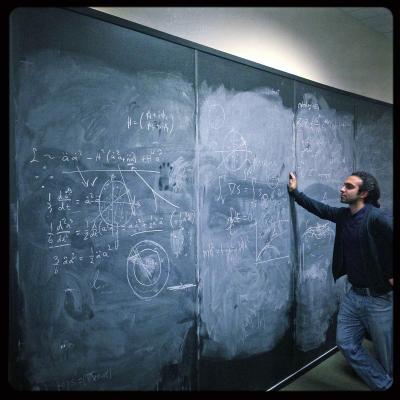The universe may be constructed in a completely different way than models of today predict. The most widely used model today cannot explain everything in the universe, and therefore there is a need to explore the parts of nature which the model cannot explain.
This research field, new physics, is out to turn our understanding of the universe upside down and the authors of a new paper say they have succeeded in creating a new method that can make it easier to search for new physics in the universe. The method is a scalesetting procedure and it fills out some empty, but very important, holes in the theories, models and simulations, which form the basis for particle physics today.
Many theories and models in particle physics today have the problem that they, together with their predictions, provide some parameters that scientists do not know how to set. The Standard Model is the prevailing theory of how the universe is constructed. According to this theory, 16 (17, with the Higgs boson) subatomic particles form the basis for everything in the universe. But the Standard Model has a limitation, in that it cannot explain gravity at the very large scale, and cannot account for the existence of dark matter, an umbrella term for what makes up about 27 percent of the universe. For comparison, normal matter is about 5 percent of the universe while 68 percent is a nebulous 'dark energy' that remains undefined. The properties of the newly discovered Higgs particle, as described in the standard model, is incompatible with a stable universe.
With the new approach, the authors say researchers can now completely clean their models for the unknown parameters and thus become better at assessing whether a theory or a model holds water.

This shows Matin Mojaza doing physics. Photo Credit: Matin Mojaza/SDU
"With this method we can eliminate much of the uncertainty in theories and models of today," says co-author and Ph.D. student Matin Mojaza from CP3-Origins. CP3-Origins is a center at University of Southern Denmark, researching in the physics beyond the Standard Model. The center focuses on topics such as dark matter, the formation of matter in the universe, and the mystery of what the Higgs particle might consist of. "Physicists do not know what values they should give these parameters. For example, when we study the Standard Model and see these unknown parameters, we cannot know whether they should be interpreted as conditions that support or oppose to the Standard Model – this makes it quite difficult to study the Standard Model accurately enough to investigate its value."
"A part of the Standard Model is the theory of quantum chromodynamics, and this is one of the first things, we want to review with our new method, so that we can clean it from the uncertainties."
The theory of quantum chromodynamics predicts how quarks (such as protons and neutrons) and gluons (particles that keeps quarks in place inside the protons and neutrons) interact.
They estimate that there may be a basis for reviewing many scientific calculations to clean the results from uncertainties and thus obtain a more reliable picture of whether the results support or contradict current models and theories. And they believe that the Standard Model needs to be extended so that it can explain the Higgs particle, dark matter and gravity.
One possibility in this regard is to examine the technicolor hypothesis, and another is supersymmetry. According to the technicolor hypothesis there is a special techni-force that binds so-called techni-quarks, which can form other particles - perhaps this is how the Higgs particle is formed. This could explain the problems with the current model of the Higgs particle. According to the supersymmetry hypothesis, each particle has a partner somewhere in the universe - though these have not been found.
Preprint: Stanley J. Brodsky, Matin Mojaza, Xing-Gang Wu, 'Systematic Scale-Setting to All Orders: The Principle of Maximum Conformality and Commensurate Scale Relations', arXiv:1304.4631
Citation: Matin Mojaza, Stanley J. Brodsky, Xing-Gang Wu, 'Systematic All-Orders Method to Eliminate Renormalization-Scale and Scheme Ambiguities in PQCD', Phys. Rev. Lett. 110, 192001 (2013) DOI: 10.1103/PhysRevLett.110.192001




Comments